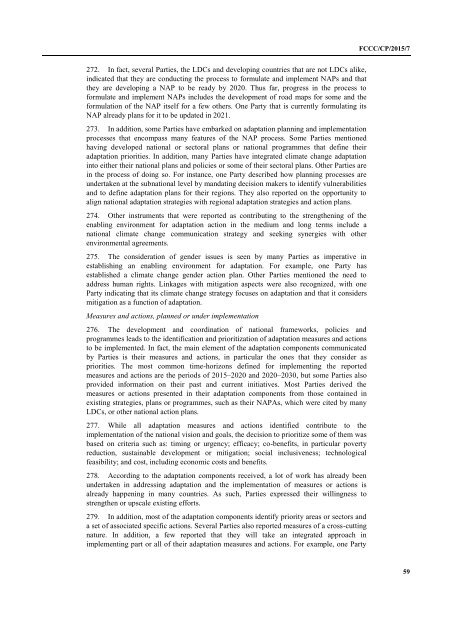FCCC/CP/2015/7
1PYuHQM
1PYuHQM
Create successful ePaper yourself
Turn your PDF publications into a flip-book with our unique Google optimized e-Paper software.
<strong>FCCC</strong>/<strong>CP</strong>/<strong>2015</strong>/7<br />
272. In fact, several Parties, the LDCs and developing countries that are not LDCs alike,<br />
indicated that they are conducting the process to formulate and implement NAPs and that<br />
they are developing a NAP to be ready by 2020. Thus far, progress in the process to<br />
formulate and implement NAPs includes the development of road maps for some and the<br />
formulation of the NAP itself for a few others. One Party that is currently formulating its<br />
NAP already plans for it to be updated in 2021.<br />
273. In addition, some Parties have embarked on adaptation planning and implementation<br />
processes that encompass many features of the NAP process. Some Parties mentioned<br />
having developed national or sectoral plans or national programmes that define their<br />
adaptation priorities. In addition, many Parties have integrated climate change adaptation<br />
into either their national plans and policies or some of their sectoral plans. Other Parties are<br />
in the process of doing so. For instance, one Party described how planning processes are<br />
undertaken at the subnational level by mandating decision makers to identify vulnerabilities<br />
and to define adaptation plans for their regions. They also reported on the opportunity to<br />
align national adaptation strategies with regional adaptation strategies and action plans.<br />
274. Other instruments that were reported as contributing to the strengthening of the<br />
enabling environment for adaptation action in the medium and long terms include a<br />
national climate change communication strategy and seeking synergies with other<br />
environmental agreements.<br />
275. The consideration of gender issues is seen by many Parties as imperative in<br />
establishing an enabling environment for adaptation. For example, one Party has<br />
established a climate change gender action plan. Other Parties mentioned the need to<br />
address human rights. Linkages with mitigation aspects were also recognized, with one<br />
Party indicating that its climate change strategy focuses on adaptation and that it considers<br />
mitigation as a function of adaptation.<br />
Measures and actions, planned or under implementation<br />
276. The development and coordination of national frameworks, policies and<br />
programmes leads to the identification and prioritization of adaptation measures and actions<br />
to be implemented. In fact, the main element of the adaptation components communicated<br />
by Parties is their measures and actions, in particular the ones that they consider as<br />
priorities. The most common time-horizons defined for implementing the reported<br />
measures and actions are the periods of <strong>2015</strong>–2020 and 2020–2030, but some Parties also<br />
provided information on their past and current initiatives. Most Parties derived the<br />
measures or actions presented in their adaptation components from those contained in<br />
existing strategies, plans or programmes, such as their NAPAs, which were cited by many<br />
LDCs, or other national action plans.<br />
277. While all adaptation measures and actions identified contribute to the<br />
implementation of the national vision and goals, the decision to prioritize some of them was<br />
based on criteria such as: timing or urgency; efficacy; co-benefits, in particular poverty<br />
reduction, sustainable development or mitigation; social inclusiveness; technological<br />
feasibility; and cost, including economic costs and benefits.<br />
278. According to the adaptation components received, a lot of work has already been<br />
undertaken in addressing adaptation and the implementation of measures or actions is<br />
already happening in many countries. As such, Parties expressed their willingness to<br />
strengthen or upscale existing efforts.<br />
279. In addition, most of the adaptation components identify priority areas or sectors and<br />
a set of associated specific actions. Several Parties also reported measures of a cross-cutting<br />
nature. In addition, a few reported that they will take an integrated approach in<br />
implementing part or all of their adaptation measures and actions. For example, one Party<br />
59


